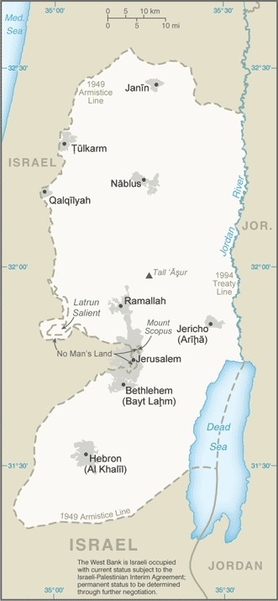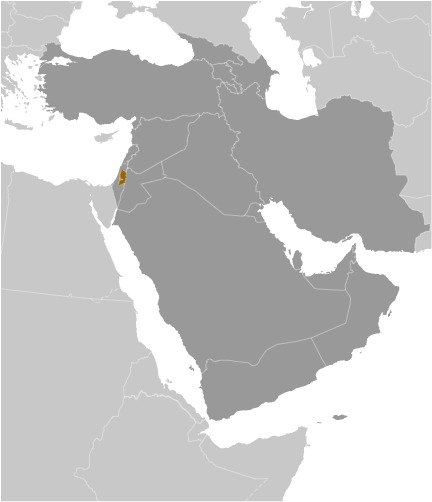West Bank
Introduction
Background
Inhabited since at least the 15th century B.C., the West Bank has been dominated by many different peoples throughout its history; it was incorporated into the Ottoman Empire in the early 16th century. The West Bank fell to British forces during World War I, becoming part of the British Mandate of Palestine. Following the 1948 Arab-Israeli War, the West Bank was captured by Transjordan (later renamed Jordan), which annexed the West Bank in 1950; it was captured by Israel in the Six-Day War in 1967. Under a series of agreements known as the Oslo accords signed between 1993 and 1999, Israel transferred to the newly created Palestinian Authority (PA) security and civilian responsibility for many Palestinian-populated areas of the West Bank as well as the Gaza Strip. In 2000, a violent intifada or uprising began, and in 2001 negotiations to determine the permanent status of the West Bank and Gaza Strip stalled. Subsequent attempts to re-start direct negotiations have not resulted in progress toward determining final status of the area.
Visit the Definitions and Notes page to view a description of each topic.
Geography
Location
Middle East, west of Jordan, east of Israel
Geographic coordinates
32 00 N, 35 15 E
Map references
Middle East
Area
total: 5,860 sq km
land: 5,640 sq km
water: 220 sq km
note: includes West Bank, Latrun Salient, and the northwest quarter of the Dead Sea, but excludes Mt. Scopus; East Jerusalem and Jerusalem No Man's Land are also included only as a means of depicting the entire area occupied by Israel in 1967
Area - comparative
slightly smaller than Delaware
Land boundaries
total: 478 km
border countries (2): Israel 330 km, Jordan 148 km
Coastline
0 km (landlocked)
Maritime claims
none (landlocked)
Climate
temperate; temperature and precipitation vary with altitude, warm to hot summers, cool to mild winters
Terrain
mostly rugged, dissected upland in west, flat plains descending to Jordan River Valley to the east
Elevation
highest point: Khallat al Batrakh 1,020 m
lowest point: Dead Sea -431 m
Natural resources
arable land
Land use
agricultural land: 43.3% (2018 est.)
arable land: 7.4% (2018 est.)
permanent crops: 11% (2018 est.)
permanent pasture: 24.9% (2018 est.)
forest: 1.5% (2018 est.)
other: 55.2% (2018 est.)
note: includes Gaza Strip
Irrigated land
240 sq km; note - includes Gaza Strip (2012)
Major lakes (area sq km)
Salt water lake(s): Dead Sea (shared with Jordan and Israel) - 1,020 sq km
note - endorheic hypersaline lake; 9.6 times saltier than the ocean; lake shore is 431 meters below sea level
Population distribution
Palestinian settlements are primarily located in the central to western half of the territory; Jewish settlements are found in pockets throughout, particularly in the northeast, north-central, and around Jerusalem
Natural hazards
droughts
Geography - note
landlocked; highlands are main recharge area for Israel's coastal aquifers; there are about 380 Israeli civilian sites, including about 213 settlements and 132 small outpost communities in the West Bank and 35 sites in East Jerusalem (2017)
People and Society
Population
2,949,246 (July 2021 est.)
note: approximately 432,000 Israeli settlers live in the West Bank (2019); approximately 227,100 Israeli settlers live in East Jerusalem (2019)
Nationality
noun: NA
adjective: NA
Ethnic groups
Palestinian Arab, Jewish, other
Languages
Arabic, Hebrew (spoken by Israeli settlers and many Palestinians), English (widely understood)
major-language sample(s):
كتاب حقائق العالم، المصدر الذي لا يمكن الاستغناء عنه للمعلومات الأساسية (Arabic)
The World Factbook, the indispensable source for basic information.
Religions
Muslim 80-85% (predominantly Sunni), Jewish 12-14%, Christian 1-2.5% (mainly Greek Orthodox), other, unaffiliated, unspecified <1% (2012 est.)
Age structure
0-14 years: 35.31% (male 525,645/female 498,458)
15-24 years: 20.75% (male 307,420/female 294,469)
25-54 years: 35.19% (male 516,758/female 503,626)
55-64 years: 5.12% (male 76,615/female 72,006)
65 years and over: 3.62% (male 48,387/female 56,650) (2020 est.)
Dependency ratios
total dependency ratio: 71.2
youth dependency ratio: 65.7
elderly dependency ratio: 5.5
potential support ratio: 18.2 (2020 est.)
note: data represent Gaza Strip and the West Bank
Median age
total: 21.9 years
male: 21.7 years
female: 22.2 years (2020 est.)
Population distribution
Palestinian settlements are primarily located in the central to western half of the territory; Jewish settlements are found in pockets throughout, particularly in the northeast, north-central, and around Jerusalem
Urbanization
urban population: 77% of total population (2021)
rate of urbanization: 2.85% annual rate of change (2020-25 est.)
note: data represent Gaza Strip and the West Bank
Sex ratio
at birth: 1.06 male(s)/female
0-14 years: 1.05 male(s)/female
15-24 years: 1.04 male(s)/female
25-54 years: 1.03 male(s)/female
55-64 years: 1.06 male(s)/female
65 years and over: 0.85 male(s)/female
total population: 1.04 male(s)/female (2020 est.)
Maternal mortality ratio
27 deaths/100,000 live births (2017 est.)
note: data represent Gaza Strip and the West Bank
Infant mortality rate
total: 15.68 deaths/1,000 live births
male: 18.14 deaths/1,000 live births
female: 13.07 deaths/1,000 live births (2021 est.)
Life expectancy at birth
total population: 76.12 years
male: 74.02 years
female: 78.36 years (2021 est.)
Contraceptive prevalence rate
57.3% (2019/20)
note: includes Gaza Strip and the West Bank
Drinking water source
improved: urban: 97.1% of population
rural: 97.1% of population
total: 96.8% of population
unimproved: urban: 2.9% of population
rural: 2.9% of population
total: 3.2% of population (2017 est.)
note: includes Gaza Strip and the West Bank
Physicians density
1.45 physicians/1,000 population (2017)
Hospital bed density
1.3 beds/1,000 population (2019)
Sanitation facility access
improved: urban: 100% of population
rural: 99.3% of population
total: 99.8% of population
unimproved: urban: 0% of population
rural: 0.7% of population
total: 0.2% of population (2017 est.)
note: note includes Gaza Strip and the West Bank
Children under the age of 5 years underweight
2.1% (2019/20)
note: estimate is for Gaza Strip and the West Bank
Education expenditures
5.3% of GDP (2018)
note: includes Gaza Strip and the West Bank
Literacy
definition: age 15 and over can read and write
total population: 97.5%
male: 98.8%
female: 96.2% (2020)
note: estimates are for Gaza and the West Bank
School life expectancy (primary to tertiary education)
total: 13 years
male: 12 years
female: 14 years (2020)
note: data represent Gaza Strip and the West Bank
Unemployment, youth ages 15-24
total: 42.1%
male: 36.6%
female: 70% (2020 est.)
note: includes Gaza Strip
Environment
Environment - current issues
adequacy of freshwater supply; sewage treatment
Air pollutants
carbon dioxide emissions: 3.23 megatons (2016 est.)
note: data represent combined total from the Gaza Strip and the West Bank.
Climate
temperate; temperature and precipitation vary with altitude, warm to hot summers, cool to mild winters
Land use
agricultural land: 43.3% (2018 est.)
arable land: 7.4% (2018 est.)
permanent crops: 11% (2018 est.)
permanent pasture: 24.9% (2018 est.)
forest: 1.5% (2018 est.)
other: 55.2% (2018 est.)
note: includes Gaza Strip
Urbanization
urban population: 77% of total population (2021)
rate of urbanization: 2.85% annual rate of change (2020-25 est.)
note: data represent Gaza Strip and the West Bank
Revenue from forest resources
forest revenues: 0% of GDP (2018 est.)
country comparison to the world: 204Waste and recycling
municipal solid waste generated annually: 1.387 million tons (2016 est.)
municipal solid waste recycled annually: 6,935 tons (2013 est.)
percent of municipal solid waste recycled: 0.5% (2013 est.)
note: data represent combined total from the Gaza Strip and the West Bank.
Major lakes (area sq km)
Salt water lake(s): Dead Sea (shared with Jordan and Israel) - 1,020 sq km
note - endorheic hypersaline lake; 9.6 times saltier than the ocean; lake shore is 431 meters below sea level
Total water withdrawal
municipal: 181.2 million cubic meters (2017 est.)
industrial: 32 million cubic meters (2017 est.)
agricultural: 162 million cubic meters (2017 est.)
note: data represent combined total from the Gaza Strip and the West Bank.
Total renewable water resources
837 million cubic meters (2017 est.)
note: data represent combined total from the Gaza Strip and the West Bank.
Government
Country name
conventional long form: none
conventional short form: West Bank
etymology: name refers to the location of the region - occupied and administered by Jordan after 1948 - that fell on the far side (west bank) of the Jordan River in relation to Jordan proper; the designation was retained following the 1967 Six-Day War and the subsequent changes in government
Economy
Economic overview
In 2017, the economic outlook in the West Bank - the larger of the two areas comprising the Palestinian Territories – remained fragile, as security concerns and political friction slowed economic growth. Unemployment in the West Bank remained high at 19.0% in the third quarter of 2017, only slightly better than 19.6% at the same point the previous year, while the labor force participation rate remained flat, year-on-year.
Longstanding Israeli restrictions on imports, exports, and movement of goods and people continue to disrupt labor and trade flows and the territory’s industrial capacity, and constrain private sector development. The PA’s budget benefited from an effort to improve tax collection, coupled with lower spending in 2017, but the PA for the foreseeable future will continue to rely heavily on donor aid for its budgetary needs and infrastructure development.
Real GDP (purchasing power parity)
$25.91 billion note: data are in 2017 dollars and includes Gaza Strip (2020 est.)
$29.26 billion note: data are in 2017 dollars and includes Gaza Strip (2019 est.)
$28.87 billion note: data are in 2017 dollars and includes Gaza Strip (2018 est.)
Real GDP growth rate
5.3% (2014 est.)
1% (2013 est.)
6% (2012 est.)
note: excludes Gaza Strip
Real GDP per capita
$5,400 note: data are in 2017 dollars and includes Gaza Strip (2020 est.)
$6,200 note: data are in 2017 dollars and includes Gaza Strip (2019 est.)
$6,300 note: data are in 2017 dollars and includes Gaza Strip (2018 est.)
note: includes Gaza Strip
GDP (official exchange rate)
$9.828 billion (2014 est.)
note: excludes Gaza Strip
Inflation rate (consumer prices)
0.2% (2017 est.)
-0.2% (2016 est.)
note: excludes Gaza Strip
GDP - composition, by sector of origin
agriculture: 2.9% (2017 est.)
industry: 19.5% (2017 est.)
services: 77.6% (2017 est.)
note: excludes Gaza Strip
GDP - composition, by end use
household consumption: 91.3% (2017 est.)
government consumption: 26.7% (2017 est.)
investment in fixed capital: 23% (2017 est.)
investment in inventories: 0% (2017 est.)
exports of goods and services: 20% (2017 est.)
imports of goods and services: -61% (2017 est.)
note: excludes Gaza Strip
Agricultural products
tomatoes, cucumbers, olives, poultry, milk, potatoes, sheep milk, eggplants, gourds
Industries
small-scale manufacturing, quarrying, textiles, soap, olive-wood carvings, and mother-of-pearl souvenirs
Industrial production growth rate
2.2% (2017 est.)
note: includes Gaza Strip
Labor force - by occupation
agriculture: 11.5%
industry: 34.4%
services: 54.1% (2013 est.)
note: excludes Gaza Strip
Unemployment rate
27.9% (2017 est.)
27% (2016 est.)
note: excludes Gaza Strip
Population below poverty line
18% (2011 est.)
Gini Index coefficient - distribution of family income
33.7 (2016 est.)
38.7 (2007 est.)
note: includes Gaza Strip
Household income or consumption by percentage share
lowest 10%: 3.2%
highest 10%: 28.2% (2009 est.)
note: includes Gaza Strip
Budget
revenues: 1.314 billion (2017 est.)
expenditures: 1.278 billion (2017 est.)
note: includes Palestinian Authority expenditures in the Gaza Strip
Fiscal year
calendar year
Current account balance
-$1.444 billion (2017 est.)
-$1.348 billion (2016 est.)
Exports
$2.65 billion note: data are in current year dollars and includes Gaza Strip (2019 est.)
$2.6 billion note: data are in current year dollars and includes Gaza Strip (2018 est.)
note: excludes Gaza Strip
Exports - commodities
stone, olives, fruit, vegetables, limestone
Imports
$9.15 billion note: data are in current year dollars and includes Gaza Strip (2019 est.)
$9.02 billion note: data are in current year dollars and includes Gaza Strip (2018 est.)
note: data include the Gaza Strip
Imports - commodities
food, consumer goods, construction materials, petroleum, chemicals
Reserves of foreign exchange and gold
$0 (31 December 2017 est.)
$583 million (31 December 2015 est.)
Debt - external
$1.662 billion (31 March 2016 est.)
$1.467 billion (31 March 2015 est.)
note: data include the Gaza Strip
Exchange rates
new Israeli shekels (ILS) per US dollar -
3.606 (2017 est.)
3.841 (2016 est.)
3.841 (2015 est.)
3.8869 (2014 est.)
3.5779 (2013 est.)
Unemployment, youth ages 15-24
total: 42.1%
male: 36.6%
female: 70% (2020 est.)
note: includes Gaza Strip
Energy
Electricity access
electrification - total population: 100% (2020)
note: data for West Bank and Gaza Strip combined
Electricity - installed generating capacity
170,000 kW (2016 est.)
note: includes Gaza Strip
Electricity - from fossil fuels
78% of total installed capacity (2016 est.)
country comparison to the world: 91Electricity - from nuclear fuels
0% of total installed capacity (2017 est.)
country comparison to the world: 211Electricity - from hydroelectric plants
0% of total installed capacity (2017 est.)
country comparison to the world: 213Electricity - from other renewable sources
22% of total installed capacity (2017 est.)
country comparison to the world: 33Refined petroleum products - consumption
24,000 bbl/day (2016 est.)
country comparison to the world: 131Communications
Telephones - fixed lines
total subscriptions: 472,293 (includes Gaza Strip) (2017 est.)
subscriptions per 100 inhabitants: 9 (includes Gaza Strip) (2016 est.)
Telephones - mobile cellular
total subscriptions: 4,135,363 (includes Gaza Strip) (2017 est.)
subscriptions per 100 inhabitants: 76 (includes Gaza Strip) (2017 est.)
Telecommunication systems
general assessment: continuing political and economic instability has impeded liberalization of the telecommunications industry (2018)
domestic: Israeli company BEZEK and the Palestinian company PALTEL are responsible for fixed-line services; two Palestinian cellular providers, JAWWAL and WATANIYA MOBILE, launched 3G mobile networks in the West Bank in January 2018 after Israel lifted its ban; fixed-line 9 per 100 and mobile-cellular 76 per 100 (includes Gaza Strip) (2019)
international: country code 970 or 972; 1 international switch in Ramallah
note: the COVID-19 pandemic continues to have a significant impact on production and supply chains globally; since 2020, some aspects of the telecom sector have experienced downturn, particularly in mobile device production; many network operators delayed upgrades to infrastructure; progress towards 5G implementation was postponed or slowed in some countries; consumer spending on telecom services and devices was affected by large-scale job losses and the consequent restriction on disposable incomes; the crucial nature of telecom services as a tool for work and school from home became evident, and received some support from governments
Broadcast media
the Palestinian Authority operates 1 TV and 1 radio station; about 20 private TV and 40 radio stations; both Jordanian TV and satellite TV are accessible
Internet country code
.psnote - same as Gaza Strip
Internet users
total: 2.673 million (includes Gaza Strip)
percent of population: 57.4% (July 2016 est.)
Broadband - fixed subscriptions
total: 371,299
subscriptions per 100 inhabitants: 14 (2017 est.)
note: includes Gaza Strip
Transportation
Airports - with paved runways
total: 2
1,524 to 2,437 m: 1
under 914 m: 1 (2013)
Heliports
1 (2013)
Roadways
total: 4,686 km (2010)
paved: 4,686 km (2010)
note: includes Gaza Strip
Military and Security
Military and security forces
per the Oslo Accords, the PA is not permitted a conventional military but maintains security and police forces; PA security personnel have operated almost exclusively in the West Bank since HAMAS seized power in the Gaza Strip in 2007; PA forces include National Security Forces, Presidential Guard, Civil Police, Civil Defense, Preventive Security Organization, the General Intelligence Organization, and the Military Intelligence Organization (2021)
note(s) - the National Security Forces conduct gendarmerie-style security operations in circumstances that exceed the capabilities of the civil police; it is the largest branch of the Palestinian Authority security service and acts as the Palestinian army; the Presidential Guard protects facilities and provides dignitary protection; the Preventive Security Organization is responsible for internal intelligence gathering and investigations related to internal security cases, including political dissent
Military and security service personnel strengths
the Palestinian Authority Security Forces have approximately 30,000 active personnel (2021)
Military equipment inventories and acquisitions
the security services are armed mostly with small arms and light weapons, although since 2007, they have received limited amounts of heavier equipment from Jordan (armored personnel carriers) and Russia (armored personnel carriers and transport helicopters) (2021)
Military expenditures
not available
Military service age and obligation
not available
Terrorism
Terrorist group(s)
Al-Aqsa Martyrs Brigade; HAMAS; Islamic Revolutionary Guard Corps/Qods Force; Kahane Chai; Palestine Islamic Jihad; Palestine Liberation Front; Popular Front for the Liberation of Palestine
note: details about the history, aims, leadership, organization, areas of operation, tactics, targets, weapons, size, and sources of support of the group(s) appear(s) in Appendix-T
Transnational Issues
Disputes - international
the current status of the West Bank is subject to the Israeli-Palestinian Interim Agreement - permanent status to be determined through further negotiation; Israel continues construction of a "seam line" separation barrier along parts of the Green Line and within the West Bank; Israel withdrew from Gaza and four settlements in the northern West Bank in August 2005; since 1948, about 350 peacekeepers from the UN Truce Supervision Organization (UNTSO), headquartered in Jerusalem, monitor ceasefires, supervise armistice agreements, prevent isolated incidents from escalating, and assist other UN personnel in the region
Refugees and internally displaced persons
refugees (country of origin): 871,537 (Palestinian refugees) (2020)
IDPs: 131,000 (includes persons displaced within the Gaza strip due to the intensification of the Israeli-Palestinian conflict since June 2014 and other Palestinian IDPs in the Gaza Strip and West Bank who fled as long ago as 1967, although confirmed cumulative data do not go back beyond 2006) (2020)
data represent Gaza Strip and West Bank



